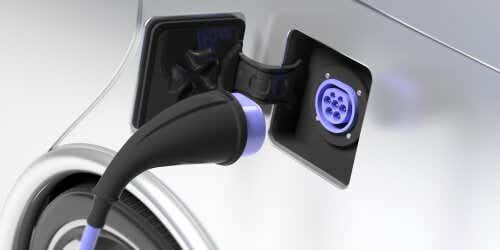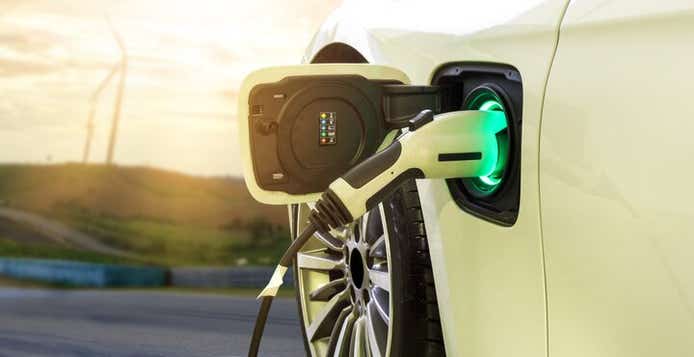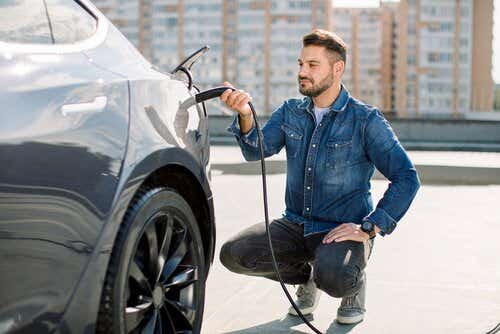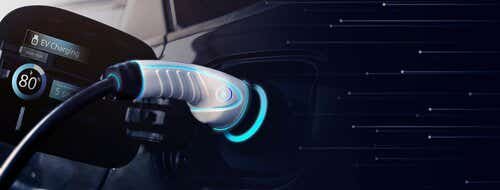How does charging an EV work?
The easiest way to think about charging an EV is in terms of charging a phone. Phone charging cables will have a connector at one end for the plug (like a USB) and a connector at the other end for the phone. You therefore need to think about the connection the vehicle needs, and the connection the charging point (whether it’s at home or out and about) needs. In practice, it’s a case of plugging one end into the charging point and the other end into the car, and then you can track the charging progress on your phone or in the car itself.
EV connector types for home charging
When charging at home, it’s highly likely you’ll be using an alternating current (AC) connector. It’s possible to charge an electric car using a standard three-pin plug that you’d use to plug any appliance into the mains supply, but this is a very slow way of charging a car. That’s why it’s recommended that electric car owners install a dedicated wall charger for use at home.
Electric cars will be fitted with either a Type 1 (if it’s an older model) or the more common (particularly for European-made models) Type 2 connector.
Most EVs are supplied with two cables: one for slow charging and one for fast charging through AC charging units. This allows them to plug into most charging points, whether they’re at home or on the go. You can buy Type 1 and Type 2 connectors for both slow and fast charging - Type 1 cables have five pins and Type 2 cables have seven pins, so a Type 1 cable for slow charging would have five pins but a charging rate of up to 3 kW, while a Type 1 cable for fast charging would have five pins but a charging rate of 22 kW. You can see more connector types in the table below.
Slow charging
An AC slow charging wall unit is commonly used at home to charge electric vehicles overnight, though they can also be found in workplaces and public charging stations. It is usually listed as having a charge rate of up to 3 kW, though charging can be carried out at anywhere between 2.3 kW and 6 kW. Slow charging connector types are available as Type 1, Type 2 or a three-pin plug.
Charging times naturally vary depending on the EV, but they could range from six to twelve hours to charge fully.
Fast charging
Fast charging units are the next step up from the slow chargers - they still use an alternating current but are rated usually at either 7 kW or 22 kW (though there may soon be direct current (DC) chargers that use CCS or CHAdeMO connectors which are rated in the same bracket at 25 kW). Fast charging connector types are available as Type 1 or Type 2.
Fast chargers can obviously charge EVs quicker than slow chargers, though, again, this will vary depending on the vehicle being charged - a 7 kW would offer up to 30 miles per hour of charging, while a 22 kW could offer as many as 90 miles per hour of charging.
It’s also worth remembering that a fast charger can only charge a vehicle according to the maximum power the vehicle accepts, regardless of how powerful the charger is. If a vehicle like the Honda e, which has a 6.6 kW onboard charger, is being charged by a 22 kW fast charger, it will only charge at a maximum rate of 6.6 kW.
Unsure if you need an EV home charger? Find the advice you need for the stage you're at here.

I'm considering buying an EV
If you're thinking about getting an EV, what do you need to consider when it comes to charging?

My EV is on the way
If you've ordered an EV, what do you need to do to prepare for its arrival?

I already have an EV
If you have an EV and you're considering installing a home charger, we can help advise you.
EV connector types for public charging
There are more options available for public charging - slow and fast charging are available, but so is rapid charging.
Rapid charging
Rapid chargers are by far the quickest way to charge an electric vehicle, but they’re the least commonly available. The electricity mains supply of most homes and workplaces in the UK cannot support a rapid charger, so they’re most often found at service stations and can only be used on vehicles with rapid charging capabilities.
Rapid chargers work with both alternating (which use a Type 2 43 kW connector) and direct currents (these use CCS and CHAdeMO 50 kW connectors).
Charging times, again, are variable depending on the vehicle, but it’s worth noting that estimates will usually assume you’re charging up to 80% of the battery’s capacity - charging times slow significantly after 80% in order to protect the battery. However, many vehicles could be charged to 80% in as little as 20-30 minutes to an hour.
Tesla owners can make use of Tesla’s Supercharger network, which uses rapid DC charging at up to 150 kW but can only be connected to with a Tesla Type 2 or CCS connector. However, Tesla drivers aren’t limited to using the company’s own public charging points - they can purchase adaptors that allow them to connect to other public charging points as well.
How do slow, fast and rapid EV connector types compare?
In the table below, you can see how the different EV charging connector types compare to each other.
| Type | Speed | Charging time | Connectors |
|---|---|---|---|
| Slow charging | Up to 3.6 kW | 6-12 hours | Standard plug (3-pin); Type 1 - 3 kW (5-pin); Type 2 - 3 kW (7-pin) |
| Fast charging | 7-22 kW | 4-6 hours | Type 1 - 22 kW (5-pin); Type 2 - 22 kW (7-pin) |
| Rapid charging | 43-50 kW | 30 mins-1 hour | Type 2 - 43 kW AC (7-pin); CHAdeMO - 50 kW DC (4-pin); CCS - 50 kW DC |
What does the future of EV charging look like?
The next generation of charging points are an upgrade on rapid charging - they’re called Ultra Rapid chargers and provide power at a charging rate of at least 100 kW, meaning that as EV capabilities evolve and battery sizes increase, charging times will still be kept to under an hour.
FAQs
What's the difference between a tethered and untethered charger?
A tethered charger is one that has a cable attached to it, meaning that only vehicles compatible with that connector type will be able to use it - a vehicle with a Type 2 connector could not use a charging unit with a Type 1 tethered cable. An untethered charger does not have a cable attached to it, which means that drivers will have to ensure they carry their own cable in the car in the event they need to charge on the go.




